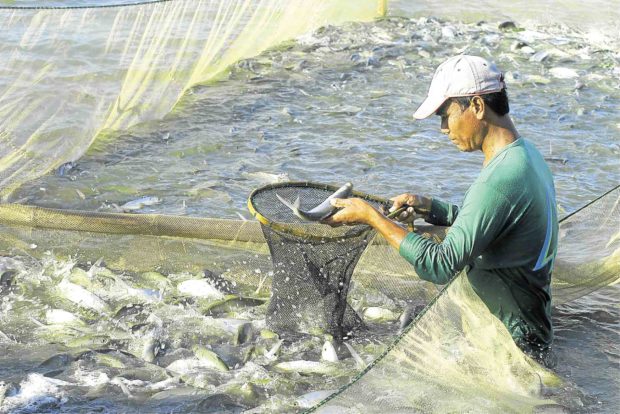PH needs fisheries department, aquaculture experts say

A fishpond helper harvests “bangus” in Dagupan City. —WILLIE LOMIBAO
DAGUPAN CITY — The government needs to create a Department of Fisheries in order to improve fish production for domestic consumption and for export, leading aquaculture experts said here on Tuesday.
Rafael Guerrero, the scientist who developed the sex reversal technology used in culturing all-male tilapia, said the country trailed behind China, Indonesia and other Asian countries in the production of tilapia, bangus (milkfish) and seaweeds.
Guerrero, who was honored along with another scientist by the National Integrated Fisheries Technology Development Center here, said the creation of a fisheries department would also enable the country to take care of its waters.
“In other countries, government support is there. They have a focus that they really carry through,” he said.
“In 1994, Indonesia set up its ministry of fisheries. The leadership was so dynamic in pursuing aquaculture, especially seaweeds … So now, they have one million hectares of seaweed farms. We have only 60,000 ha,” Guerrero said.
Article continues after this advertisementThe Philippines is the world’s fifth-biggest tilapia producer, behind Bangladesh, Egypt, Indonesia and China, he said.
Article continues after this advertisementGuerrero said government policies were also “not favorable [to the industry] and they kept changing.”
The country’s fishery sector is currently administered by the Bureau of Fisheries and Aquatic Resources (BFAR), which is under the Department of Agriculture.
“Sadly, the situation of aquaculture in the country is rather dismal. For the past six years, our production has been going down in all species, such as milkfish, tilapia and seaweeds, to the extent that some of our neighbors who came later are now producing more than we do,” said Wilfredo Yap, executive director of the Santeh Aquaculture Science and Technology Foundation Inc.
Yap said the country’s tilapia production had remained at 270,000 metric tons (MT) annually while Bangladesh, which started producing tilapia in 2010, was producing about 320,000 MT a year.
Milkfish production was good 10 years ago, when BFAR was actively promoting the mariculture park system, Yap said.
“We had them all over the country. After the change in BFAR administration, there was a change in thrust so that promoting aquaculture took a backseat. They went into enforcing regulations,” he said.
As a result, bangus production remained at about 400,000 MT a year, while while Indonesia produces 650,000 MT annually, Yap said.
Guerrero said the creation of a fisheries department would be a “political decision.” —Gabriel Cardinoza